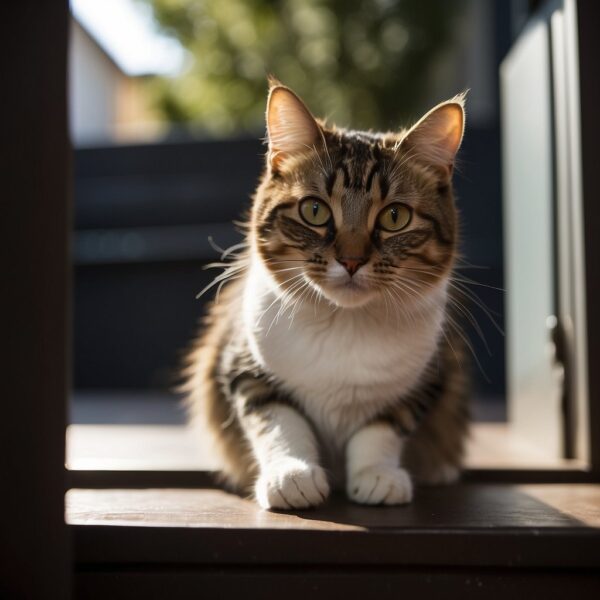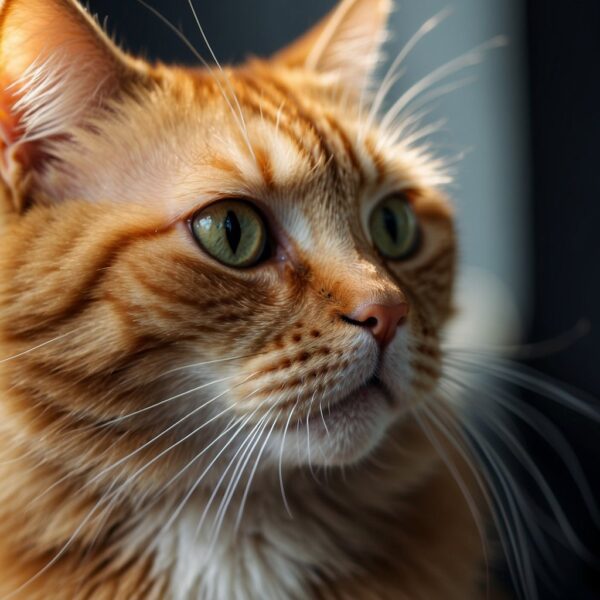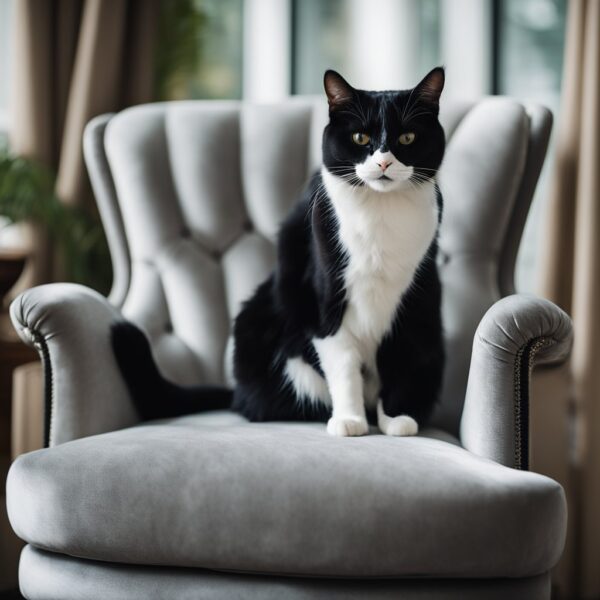
Your Cat’s Surprising Observations
Your cat knows things about you! Cats are keen observers of human behavior. Your cat knows when you are feeling stressed or scared, even if you try to hide it. Their sharp senses can pick up on subtle changes in your scent and body language, which helps them understand your emotions.
Cats also pay close attention to your daily routines. From the time you wake up to when you go to bed, your cat notices your patterns and adapts to them. This awareness creates a strong bond between cats and their human parents, making them reliable and affectionate pets.
Your feline friend is not just a passive observer; they actively respond to your actions and emotions. Whether they curl up next to you when you’re down or greet you at the door after a long day, their behavior is a testament to their intelligence and emotional connection with you.
Key Takeaways
- Cats sense your emotions and stress levels.
- Felines adapt to your routines and behaviors.
- They show intelligence through their responses to you.

Communication Between Cats and Humans
Cats use a mix of body language, vocalizations, and facial expressions to convey their feelings and needs. Recognizing these signals can help you better understand and connect with your feline friend.
Deciphering Cat Body Language
Cats often communicate their mood through their body. For instance, a cat with an arched back and puffed-up tail is feeling threatened. A slowly wagging tail can indicate irritation, while a tail held high usually means confidence and happiness.
A cat’s ears are also telling. Forward-facing ears indicate a relaxed and curious cat, whereas ears flattened against the head can signal fear or aggression.
Body posture is key, too. A cat laying on its side, showing its belly, is feeling secure and trusting. Yet, rolling onto its back can also be a defensive posture, so context matters.
Vocalizations and What They Mean
Cats have a range of vocal sounds, each with its own meaning. A meow can be a greeting or a demand for attention. Continuous meowing might indicate a need or discomfort, such as hunger or illness. Purring usually means contentment but can also signify that a cat is in pain or anxious.
Hissing and growling are clear signs of fear or aggression and should not be ignored.
Chirping or chattering is often observed when a cat watches birds through a window. It’s believed to express excitement or frustration.
Facial Expressions and Movements
A cat’s face can speak volumes. Slow blinking is a sign of trust and affection. If a cat slow blinks at you, blinking back can strengthen your bond.
Eyes wide open with dilated pupils can show excitement or fear, while half-closed eyes often indicate relaxation.
Whisker position matters, too. Whiskers pushed forward are a sign of curiosity or interest. Pulled-back whiskers may indicate a cat is frightened or feels threatened.
By recognizing these subtle signals, you can better respond to your cat’s needs and emotions. Understanding your feline’s unique ways of communicating can enhance your relationship and ensure a happy coexistence.
Your Cat Knows Things About You: The Emotional Connection
Cats may appear independent, but they have a deep emotional connection with their human parents. They sense your feelings, know your routines, and recognize your moods. Here’s a look at how well your cat understands you.
Your Cat Knows When You Don’t Feel Well
Cats can tell when you are sick or stressed. Their keen senses pick up on changes in body language, tone of voice, and even scent. When you’re unwell, your cat might spend more time near you, providing comfort. This behavior shows their awareness of your state and their role in offering support.
Your Cat Knows Where You are in the House
Cats are adept at tracking your movements around the house. They use their acute hearing to locate you, even when you’re out of sight. When your cat follows you from room to room, it indicates how much they value your presence. This behavior strengthens their bond with you, making them feel more secure.
Your Cat Knows When You Are Getting Ready to Leave
Cats learn to recognize the signs when you’re about to leave. They might notice when you pick up your keys or put on your shoes. This awareness can cause them stress, as they prefer routine and stability. Some cats may react by hiding or becoming more vocal, showing their reluctance for you to go.
Your Cat Knows Where You Have Been
Cats have a remarkable sense of smell. They can detect where you’ve been by sniffing your clothes or bags. This ability helps them understand their environment and your activities. Recognizing familiar scents reassures them and can be a way for them to feel connected to you even when you’re not physically present.
Your Cat Knows When You Are Happy and Sad
Cats are sensitive to your emotions. They can sense when you’re happy or sad through your facial expressions and body language. When you’re happy, your cat might be more playful and engaging. Conversely, if you’re sad, your cat might stay close and offer quiet companionship, showing empathy for your feelings.
Your Cat Knows When You Are Afraid
When you’re scared, your cat can often pick up on your fear. Changes in your heartbeat, sweat, and adrenaline levels can be detected by your cat. They might respond by either becoming more alert or seeking comfort from you, reflecting their concern for your well-being.
Your Cat Knows You Respond To Their Meows
Cats communicate with their meows, and they know that you respond to them. Each meow can convey different needs, such as hunger, attention, or distress. By listening and reacting to your cat’s meows, you build a communicative bond. This interaction is a significant part of your relationship, showing your cat that they are heard and cared for.
Your Cat Knows You Love Them
Cats recognize acts of love from you. Petting, playing, feeding, and talking to your cat are signs of affection they understand. When your cat purrs, rubs against you, or chooses to sleep near you, they are responding to your love. These actions reinforce the emotional connection between you and your kitty.

Cat’s Perception of Time and Routine
Cats perceive time and follow routines in ways that often align with our schedules. They rely on their internal clocks and environmental cues to maintain their daily activities.
Your Cat Knows Your Schedule
Cats are observant and quickly learn your routines. They notice when you leave for work and when you return. By watching these patterns, cats come to anticipate meal times, play sessions, and even when you’ll likely give them attention.
Their ability to predict your schedule is driven by changes in light, sounds, and your movements. If you typically feed your cat in the morning, they will often wait by their food bowl around that time. If you usually come home at 6 PM, your cat might wait by the door as that time approaches.
Internal Clock and Daily Activities
Cats have an internal clock that helps them keep track of time. This internal clock is influenced by their circadian rhythms, which are the natural cycles of wakefulness and sleep closely tied to daylight.
These rhythms help cats know when it’s time to eat, sleep, or play. Their internal clock works in tandem with their acute sense of smell. For example, the smell of breakfast or dinner cooking can signal to a cat that it’s time to eat.
The combination of these factors helps cats establish and stick to a consistent daily routine, which makes them feel secure and comfortable.

Navigating the Human-Cat Relationship
Cats often seem aloof or independent, but they also need affection and trust to build a strong relationship with humans. Understanding their behaviors and communication methods can enhance this bond.
Building Trust with Your Cat
Trust is the foundation of any relationship, including with cats. To build trust, handle kittens early on. The more they are handled, the friendlier they become. Gentle petting, especially around the head and chin, can encourage better interactions.
Cats show trust with head butts and leaning into pets. Respecting their space is also key. If a cat walks away, give it time to return on their own terms.
The Role of Scents in Communication
Scents play a significant role in cat communication. Cats have scent glands around their face, paws, and tail. They rub these areas to mark their territory and humans with their scent.
Scent marking shows possession and familiarity. It can be soothing for cats and is essential for their sense of security. By recognizing these signs, humans can better understand and respond to their cat’s needs.
Independence vs Attachment
Cats balance independence with affection. Though often seen as solitary animals, they can form deep attachments to you.
Signs of attachment include following humans around and vocalizing. However, cats value their independence and may need alone time.
It’s important to give cats space when needed. Allowing them to approach on their own terms helps maintain a healthy relationship. Balancing affection and independence fosters a happier, more trusting bond with your cat.

Interpreting Cat Behaviors and Actions
Cats exhibit behaviors that convey their emotions and desires, indicating how they feel about their environment and their human companions. Understanding these behaviors can improve the bond between cats and their parents.
Signs Your Cat May Be Trying to Communicate
Cats use a variety of signals to communicate. A tail held high often indicates confidence and friendliness. Conversely, a tucked tail may signal fear or submission. Ears that point forward show curiosity, while flattened ears can mean anger or fear.
Vocalizations are also important. A purring cat is usually content, while a hissing cat feels threatened. Meowing can indicate a variety of things, from hunger to a desire for attention or interaction.
Body posture provides clues. An arched back often shows readiness to defend. Lying on the back with exposed belly can mean trust, but it can also be a defensive posture.
Grooming and Bonding Rituals
Grooming is a bonding activity. Cats often groom each other to strengthen social bonds. When a cat grooms you, it shows affection and considers you part of its social circle.
Licking serves multiple purposes. Besides hygiene, licking can be a sign of comfort and care. Cats lick to show companionship or to soothe themselves.
Head-butting, or ‘bunting,’ is another way cats mark their territory with scent glands located on their heads. When your cat head-butts you, it transfers its scent, marking you as safe and familiar.
Predicting Cat Behavior
Cats have predictable patterns. A change in routine, like eating or sleeping habits, can signal health issues. It’s important to observe any deviations from their normal behavior.
Play behavior is essential. Play-mimicking hunting helps cats exercise and stay mentally active. Interactive play sessions can reduce aggression and improve their well-being.
Telltale signs can help predict behavior. Dilated pupils and a twitching tail might precede pouncing or play attacks. If you notice these signs, engage your cat with a toy to redirect the energy constructively.
Observing their environment also helps in predicting actions. Cats feel safe when they have high vantage points and hiding spots. Providing these can prevent stress-related behaviors.
Understanding Cat Intelligence
Cats are intelligent creatures with a variety of cognitive abilities. They have strong memories and can recognize individual people and situations. Their behavior also reflects their sharp sensory understanding.
Cognitive Abilities of Cats
Cats have brains that are similar in structure to human brains. This similarity allows them to perform complex tasks. They understand object permanence, meaning they know that objects continue to exist even when they can’t see them. This cognitive ability helps them during hunting and play.
Cats are also capable of learning from their environment. They observe and mimic behaviors, showing an ability to problem-solve. For example, they might figure out how to open doors or drawers by watching humans. This indicates a high level of learning and adaptation.
Memory and Recognition
Memory is a key component of feline intelligence. Cats can remember people, places, and events for long periods. This is why they may recognize their parents even after a long absence. They can also recall the location of hidden objects or their favorite hiding spots.
Cats show recognition through their actions. They can differentiate between familiar and unfamiliar faces. They respond to their names and even recognize the tone of voice used by their owners. This suggests that their memory and recognition skills are highly refined.
Sensory Understanding in Feline Behavior
Cats possess an extraordinary sense of smell and acute hearing. These heightened senses play a significant role in their behavior and perception. Their sense of smell is 14 times stronger than that of humans. This allows them to detect scents in their environment, which can influence their behavior.
Hearing is another area where cats excel. They can hear higher frequency sounds that are inaudible to humans. This helps them in detecting prey and staying alert to their surroundings. These sensory abilities contribute to their overall intelligence and ability to navigate their world.

Frequently Asked Questions
Cats have unique ways of showing affection and can sense their parents emotions. They use specific behaviors to bond with and communicate with their human companions.
How can you tell if your cat feels a strong bond with you?
A cat that feels a strong bond might follow you around, sleep near you, or gently head-butt you. Purring when around you and seeking your attention are also clear signs of a strong connection.
What methods do cats use to communicate their understanding of their Human Parents?
Cats use meowing, purring, and body language to communicate. They might meow in different tones to convey needs or use their tails and ears to express emotions like happiness or irritation.
Is it possible for a cat to differentiate between various members of a household?
Yes, cats can tell the difference between household members. They might have unique behaviors for each person, such as greeting one person at the door or sitting on another’s lap. Cats learn individuals’ routines and adjust their interactions accordingly.
In what ways do cats exhibit trust and affection towards their chosen person?
Cats show trust by exposing their bellies, which is a vulnerable area. They might also knead their paws on their favorite person or bring small “gifts” like toys. Eye contact and slow blinking are further signs of affection.
Can cats recognize and respond to their Parents’ emotional states?
Cats are very perceptive and can sense emotions like stress, fear, and happiness. They might come and sit on your lap when they feel down or act playful when you are happy. Changes in scent due to emotions can also clue cats in.
What behaviors indicate that a cat perceives You as a parental figure?
Kneading is a behavior from kittenhood that cats often direct toward you, similar to how they knead their mother for milk. Following you around, seeking comfort, and engaging in grooming behaviors are additional indicators.